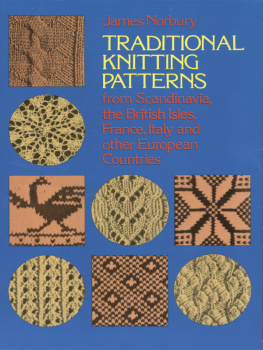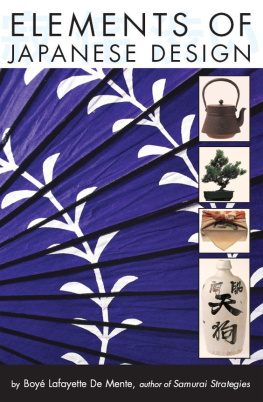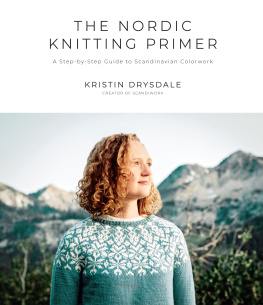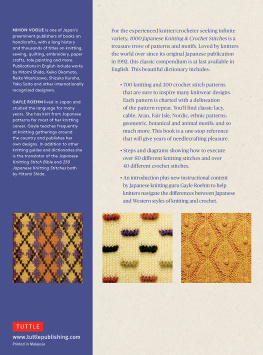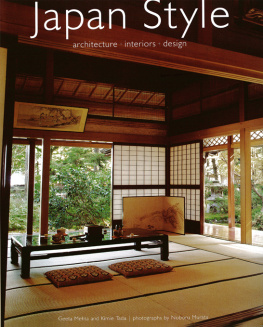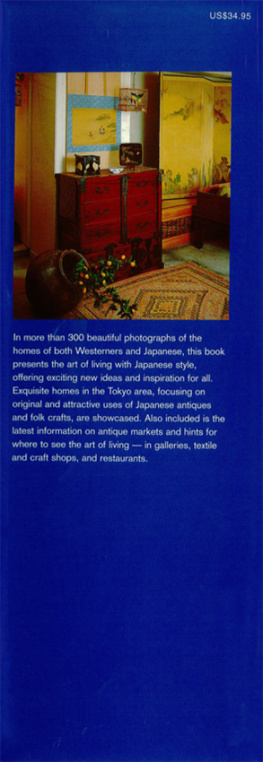
Japanese
Inspired Knits
Marianne Isager Collection

Contents

Introduction
I am not exactly sure when my interest in Japanese art began, but my first memory is of three lovely wood blocks with Japanese birds that I received as a confirmation gift from my Aunt Gertrud and Uncle Niels. They had a central place in my room when I was a teenager.
Japanese art and culture played a big part at design school, and I was enchanted by exhibitions at the Louisiana Museum of Modern Art (Humlebk, Denmark) and the Danish Art Industry Museum (Copenhagen, Denmark). Later on, along with several other handcraft workers, I was invited to participate in an exhibit in Tokyo. Much of the inspiration I gathered has been used in my handknitted garments. The reaction from the organizers of the Japanese exhibit surprised methey didnt recognize much Japanese influence in my knitting; instead they exclaimed, How very Scandinavian.
The garments in this book are also not Japanese but express the inspiration I receive from living in Japan for most of the year. I am always surprised by the finesse of daily life; for example, the ways food is packed and served, exhibits, shows, and the special respect paid to fellow citizens who live in close proximity while remaining very private.
The sounds of city life are a chapter in themselves. There is the whistling of the tofu seller as he cycles around backstreets to sell freshly made tofu. There is the special melody that lets you know that the sweet steamed potatoes are now on the street or where the long poles used for washing and airing of futons can be bought. There are so many little activities associated with daily routine in Japan that have given me a sense of calmness and allow me to immerse myself in each new knitting project.
I hope this book will give you a glimpse of the happiness that I have found in Japan and at the same time give you a picture of how the seasons move through the year on the other side of the world.
With best wishes for good knitting, Marianne



In Japan, we celebrate the New Year in January by going to the temple shortly before midnight. We write out our resolutions and secret wishes on small wooden plaques decorated with the animal motif of the year we are about to enterdog, pig, sheep, goat, etc. To prepare for the New Year, we clean up our homes and make decorations to invite the gods to visit. We also prepare special food to eat on the first day of the new yearalong with a lot of sake. One special treat is winter mikanlittle orange fruits loaded with vitamin C that help us withstand the cold Japanese winter. A January specialty is skagami-mochi, which is a two-layer viscous, sticky rice cake. A smaller piece is laid over a larger one as a symbol of the new year taking over the old. On the second Monday in January, anyone who is celebrating their twentieth birthday goes to the temple where prayers are said for a good life path. The girls, of course, wear their fine kimonos.

Download the charts for this project here.
FINISHED SIZE
36 (42, 48)" (92.5 [106.5, 122] cm) bust circumference, tied. Sweater shown measures 42" (106.5 cm).
YARN
About 250 (300, 350) grams of main color 1 (MC1) and 325 (350, 400) grams of main color 2 (MC2) used held tog; and about 100 grams each of two accent colors A and B of fingering-weight (Super Fine #1) yarn.
Shown here: Isager 1 (100% wool; 340 yd [311 m]/50 g): #0 natural (MC1), 5 (6, 7) skeins.
Alpaca 2 (50% merino, 50% alpaca; 270 yd [247 m]/50 g): #2105 light gray heather (MC2), 7 (7, 8) skeins; #011 steel blue (A) and #012 grayed olive (B), 2 (2, 2) skeins each. Note: Use one strand each of Isager 1 and Alpaca 2 held together for MC.
NEEDLES
Double knitting lower fronts and cuffssize U.S. 2 (3 mm): straight. Body and sleevessize U.S. 4 (3.5 mm): straight and 24" or 32" (60 or 80 cm) circular (cir). Adjust needle size if necessary to obtain the correct gauge.
NOTIONS
Stitch holders; stitch markers; cable needle (cn); tapestry needle.
GAUGE
22 sts (one layer) and 37 rows = 4" (10 cm) counted on one face of double-knitting patterns from charts on smaller needles (see ); 22 stitches and 38 rows = 4" (10 cm) in seed stitch on larger needles with one strand of each MC held together; 16 stitches of Aran pattern = 2" (5 cm) on larger needles with one strand of each MC held together.
STITCH GUIDE
Seed Stitch
(worked over an even number of sts) Set-up Row: (WS) *K1, p1; rep from *.
ROW 1: (RS) *P1, k1; rep from.
ROW 2: *K1, p1; rep from *.
Repeat Rows 1 and 2 for pattern; do not repeat the set-up row.
Aran Pattern
(multiple of 8 sts)
ROW 1: (RS) *Sl 2 sts onto cn and hold in back, k2, k2 from cn, sl 2 sts onto cn and hold in front, k2, k2 from cn; rep from *.
ROWS 2, 4, AND 6: Purl.
ROWS 3 AND 7: Knit.
ROW 5: *Sl 2 sts onto cn and hold in front, k2, k2 from cn, sl 2 sts onto cn and hold in back, k2, k2 from cn; rep from *.
ROW 8: Purl.
Repeat Rows 18 for pattern.
NOTES
- The back, fronts, and sleeves are worked separately to the armholes, then the pieces are joined for working the yoke in one piece to the back neck edge. After binding off the back neck stitches, the remaining stitches for the sleeve and front at each side are worked separately as shawl collar extensions that are seamed together at center back.
- In the jacket worn by the model on . The colors in the pattern directions and charts correspond to the jacket shown photographed flat, without the model.
- Double knitting (see ) simultaneously forms two layers of knitted fabric. The stitches of the two layers alternate on the needle. Using two colors creates a reversible color pattern as you interchange the yarns for the two layers.
- The charts show one face of the double knitting fabric. Each row on a chart is one row of knitting for both layers. Except for the selvedge stitches, one grid square of the chart represents two stitches on the needlea knit stitch for the side of the fabric facing toward you (the front of the work at that moment) and a purl stitch for the side of the fabric facing away from you (the back of the work at that moment). The knit stitch forms the right side of the front fabric, and the purl stitch forms the wrong side of the back fabric. When working double knitting back and forth in rows, read the odd-numbered rows of the chart from right to left, working the knit stitch of each pair in the color shown on the chart and the purl stitch in the opposite color. Read the even-numbered rows from left to right, working the knit stitch for each pair in the opposite color and the purl stitch in the color shown on the chart. Any selvedge stitches should be worked as indicated in the directions.


